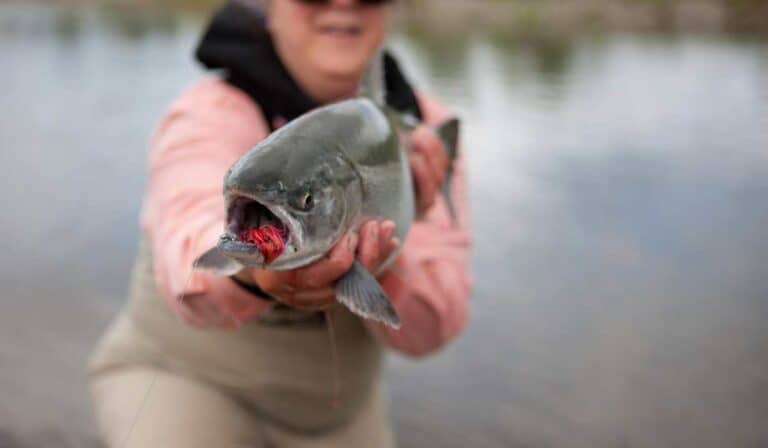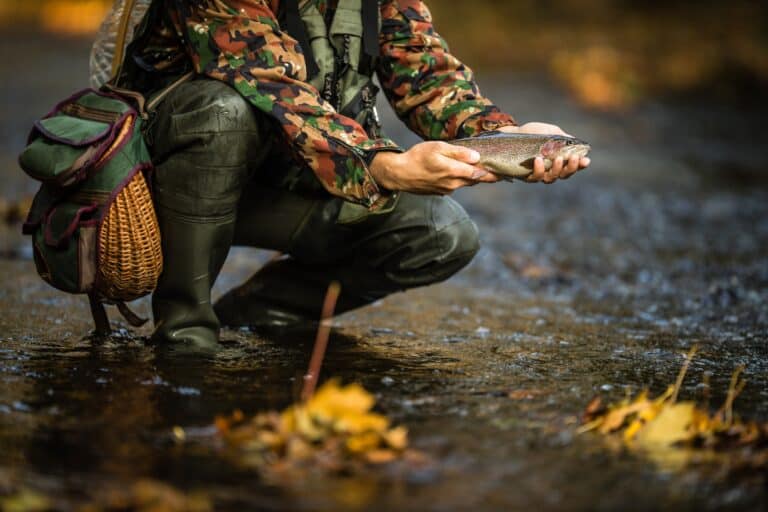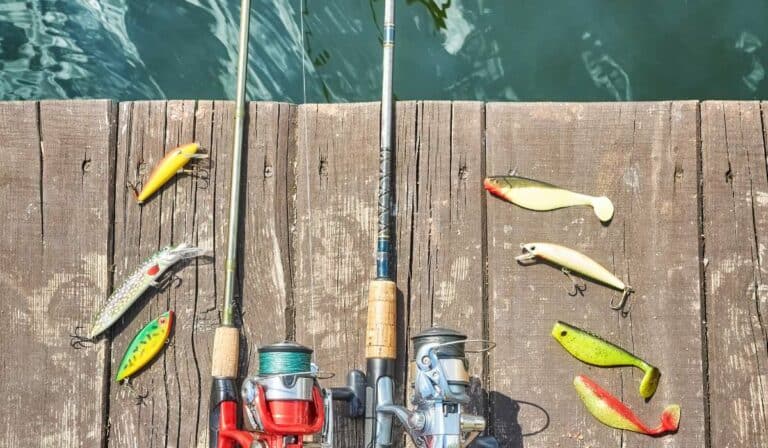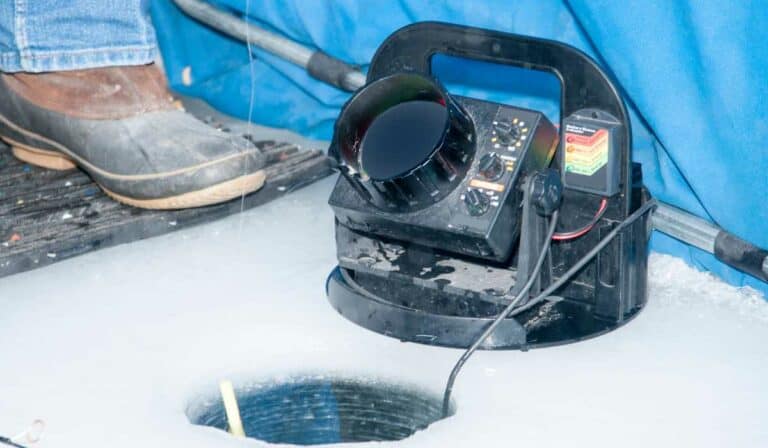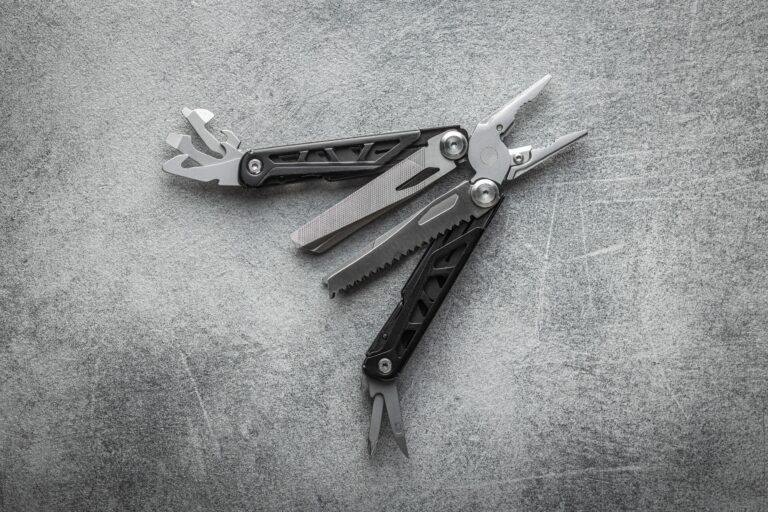Best Ice Fishing Tools – What You Need Before Heading Out On The Ice
Having the proper tools and equipment are essential to a safe and successful ice fishing excursion. In this guide, we will explore various aspects of ice fishing gear to help you make the best decisions when purchasing or upgrading your ice fishing equipment.
We’ll start by discussing how to choose the perfect ice fishing rod tailored to your needs and preferences. Next, we’ll delve into essential tackle items that every angler should have in their arsenal. Afterward, we’ll compare some of the best ice fishing reels available in today’s market – from spinning reels to inline reels.
As drilling through thick layers of ice is an integral part of this sport, selecting an efficient and reliable auger is crucial; hence, our discussion about hand augers versus electric ones. Furthermore, we will examine different types of lines suited for icy conditions and share valuable tips for setting up your gear effectively.
Last but not least, safety should never be overlooked when venturing out on treacherous terrain; therefore, we will conclude with vital precautions one must take during any ice fishing expedition.
Table of Contents:
- Choosing the Right Ice Fishing Rod
- Essential Ice Fishing Tackle
- Best Ice Fishing Reels
- Selecting an Ice Auger
- Best Ice Fishing Line
- Tips for Setting Up Your Ice Fishing Gear
- Safety Tips When Ice Fishing
- A. Check Ice Thickness
- B. Dress Appropriately
- C. Bring Essential Safety Gear
- D. Fish with Friends
- E. Be Aware of Changing Conditions
- FAQs in Relation to Best Ice Fishing Tools
- Conclusion

1. Choosing the Right Ice Fishing Rod
Finding the perfect ice fishing rod is essential for a successful and enjoyable experience out on the ice. Navigating the huge selection of ice fishing rods available can be overwhelming when trying to find one that fits your needs. In this section, we will discuss some tips for selecting an ideal ice fishing rod.
A. Consider Your Target Species
Deciding on an ice fishing rod should begin with assessing the species of fish you plan to pursue. Different rods are designed for different types of fish, so knowing your target species will help narrow down your choices. For example, if you’re targeting panfish like crappie or bluegill, a light or ultralight action rod would be suitable as they provide better sensitivity and control when using small baits and lures (source). On the other hand, if you’re going after larger game fish such as walleye or pike, a medium-heavy action rod with more backbone may be necessary.
B. Choose The Right Length And Action
Ice fishing rods typically range from 24-36 inches in length; however, longer rods up to 48 inches are also available (source). Shorter rods offer better control and sensitivity while jigging but may limit casting distance when needed.
- Short (24-28 inches): Ideal for tight spaces inside shelters and increased sensitivity when jigging close quarters.
- Medium (29-34 inches): A versatile option that provides both good casting distance and jigging capabilities.
- Long (35-48 inches): Best for increased casting distance and deeper water fishing.
The action of a rod refers to how much it bends when pressure is applied. A fast-action rod will bend mostly near the tip, while a slow-action rod will bend throughout its entire length. For ice fishing, medium or fast action rods are generally preferred as they provide better sensitivity and hook-setting power (source). However, if you’re targeting smaller fish species like panfish, an ultralight or light action may be more suitable.
C. Look For Quality Components And Materials
A high-quality ice fishing rod should have durable components such as stainless steel guides and a comfortable handle made from materials like cork or EVA foam. The blank material is also important; graphite blanks offer excellent sensitivity but can be brittle in cold temperatures, so consider fiberglass or composite options for added durability (source).
D. Test The Rod In Person If Possible
If possible, try out different ice fishing rods in person before making your decision. This allows you to get a feel for the weight balance and overall comfort of each option – factors that can significantly impact your enjoyment on the ice.
Taking these tips into consideration will help ensure that you select an ideal ice fishing rod tailored to your specific needs and preferences.
Choosing the right ice fishing rod is essential to ensure a successful and enjoyable day on the lake. To ensure a successful outing, it is important to select the right tackle for your ice fishing expedition.
Key Points To Remember:
To have a successful ice fishing experience, it’s important to choose the right rod. Consider your target species and select the appropriate length and action for your needs. Look for quality components and materials, and if possible, test out different rods in person before making a decision.
Also check out our guide to the best saltwater fishing tools.
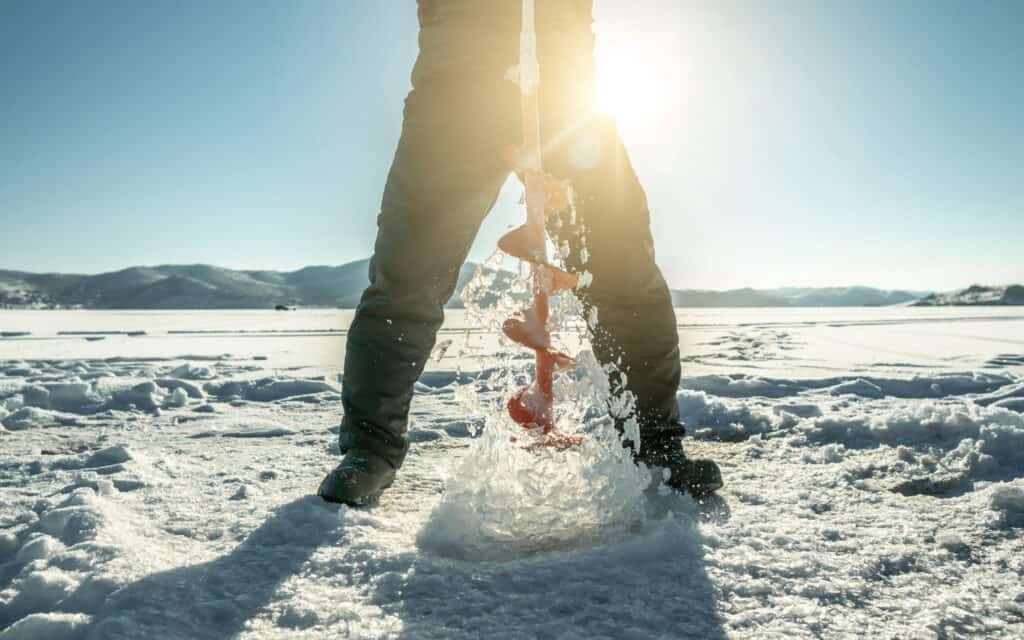
2. Essential Ice Fishing Tackle
Having the right tackle and gear is crucial for a successful ice fishing trip. When heading out on the ice, it’s important to have the necessary tackle and gear for a successful fishing trip.
A. Jigs and Lures
Jigs and lures are important components of your ice fishing arsenal. There are various types to choose from, each designed to attract different species of fish in specific conditions. Some popular options include spoon jigs, teardrop jigs, and jigging rapalas. Experiment with different styles and colors to find what works best for your target species.
B. Bait
Live bait is often preferred by many anglers due to its effectiveness in attracting fish under the ice. Common choices include waxworms, spikes (maggots), minnows, or even shrimp. Be sure to check local regulations regarding live bait usage before heading out on your adventure.
C. Tip-ups
Tip-ups are an excellent addition to any angler’s toolkit as they allow you to cover more water while waiting for that big catch. These devices hold your line above the hole while signaling when a fish takes the bait – allowing you time to react accordingly without constantly monitoring every rod yourself.
Digital vs Mechanical Tip-Ups:
- Digital tip-ups: Feature electronic sensors that detect strikes with precision accuracy; these models typically require batteries but offer convenience through wireless alerts sent directly to your smartphone.
- Mechanical tip-ups: Utilize a spring-loaded flag system to signal when a fish has taken the bait; these models are generally more affordable and do not require batteries but may be less sensitive than their digital counterparts.
D. Tackle Box Essentials
In addition to jigs, lures, and bait, there are several other items you should have in your tackle box for an enjoyable ice fishing experience:
- Assorted hooks: Carry various sizes and styles of hooks suitable for different species of fish.
- Split shot sinkers: These small weights help keep your line at the desired depth while jigging or using live bait rigs.
- Fishing swivels: Swivels prevent line twists that can lead to tangles or weakened lines – ensuring smooth reel operation throughout the day.
- Pliers/hook remover: A fishing multi-tool is a must-have tool for safely removing hooks from caught fish without causing harm to yourself or the catch-and-release specimens.
By having all these essential ice fishing tackle items on hand, you’ll be well-prepared for any situation out on the frozen water. Happy angling.
Essential winter fishing tackle is a necessity for any successful angler, and having the right gear can make all the variance in your success. Moving on to another important part of an ice fisher’s gear: best ice fishing reels.
Key Points To Remember:
To have a successful ice fishing trip, it’s important to have the right tackle and gear. Essential items include jigs and lures, live bait such as waxworms or minnows, tip-ups (either digital or mechanical), assorted hooks, split shot sinkers, fishing swivels, and pliers/hook remover for safely removing caught fish.
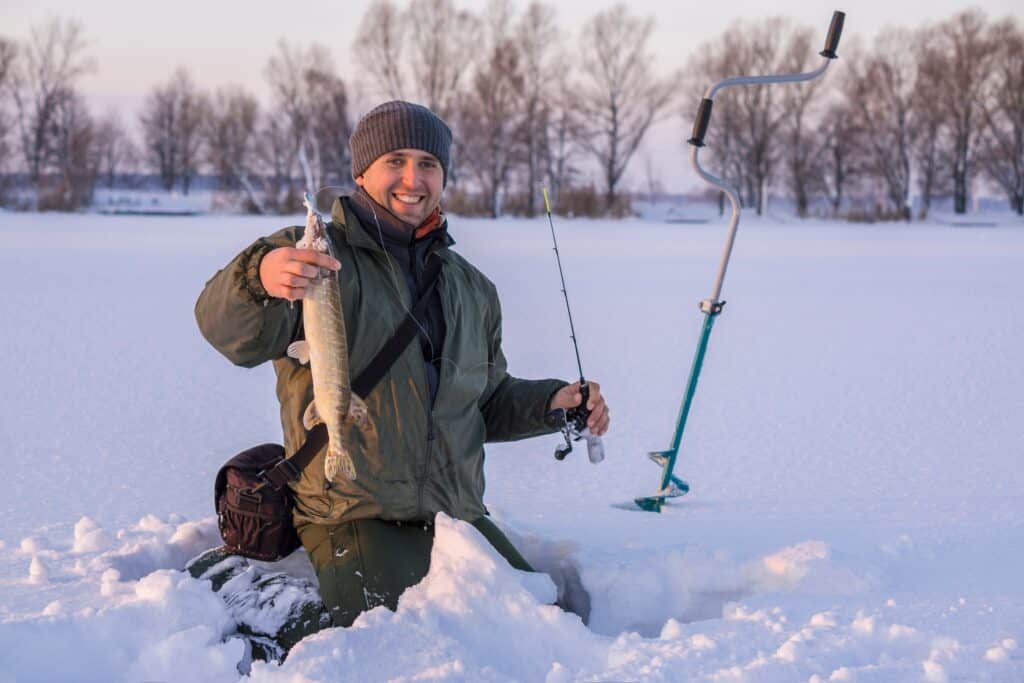
3. Best Ice Fishing Reels
The perfect reel can not only make your ice fishing outing more successful, but also ensure that you have a pleasurable experience. In this section, we’ll review some of the top-rated ice fishing reels available today, helping you find one that suits your needs.
a) Inline Ice Fishing Reels
Inline reels are specifically designed for ice fishing and offer several advantages over traditional spinning or baitcasting reels. These include reduced line twist, improved sensitivity, and better control when jigging through the ice. Some popular inline reels worth considering are:
- 13 Fishing Black Betty FreeFall Ghost
- Frabill Straight Line 371 Bro Series
- Eagle Claw Inline Ice Reel
b) Spinning Ice Fishing Reels
If you prefer using a spinning reel while out on the ice, there are plenty of options available as well. Here are some highly recommended spinning reels suitable for ice fishing:
- Shimano Sienna FE
- Pflueger President Spinning Reel
- Abu Garcia IceMax Spinning Reel
c) Baitcasting Ice Fishing Reels
While not as common for ice fishing, baitcasting reels can still be a viable option for those who prefer them. Here are some top-rated baitcasting reels suitable for ice fishing:
- Lew’s Speed Cast Baitcast Reel
- Shimano Curado K Baitcast Reel
- Abu Garcia Black Max Low Profile Baitcasting Reel
Tips for Choosing the Best Ice Fishing Reel for You
With so many options available, it can be difficult to decide which ice fishing reel is right for you. Here are some tips to help narrow down your choices:
- Consider the type of reel that best suits your preferences and experience level (inline, spinning, or baitcasting).
- Look for reels with a smooth drag system to ensure consistent pressure on the line when fighting fish.
- Choose a reel with an appropriate gear ratio for the style of fishing you plan on doing – higher gear ratios are better suited for jigging while lower ratios work well for slower presentations.
By taking these factors into consideration and exploring our recommendations above, you’ll be well on your way to finding the perfect ice fishing reel.
When selecting the best ice fishing reel, consider your budget and intended use of the product. The next heading discusses how to select an ice auger that will meet all of your needs for a successful day on the lake.
Key Points To Remember:
This section reviews the best ice fishing reels available today, including inline, spinning, and baitcasting options. Tips for choosing the right reel include considering your experience level and preferences, looking for a smooth drag system and appropriate gear ratio. With these factors in mind, you’ll be able to find the perfect reel for a successful ice fishing trip.
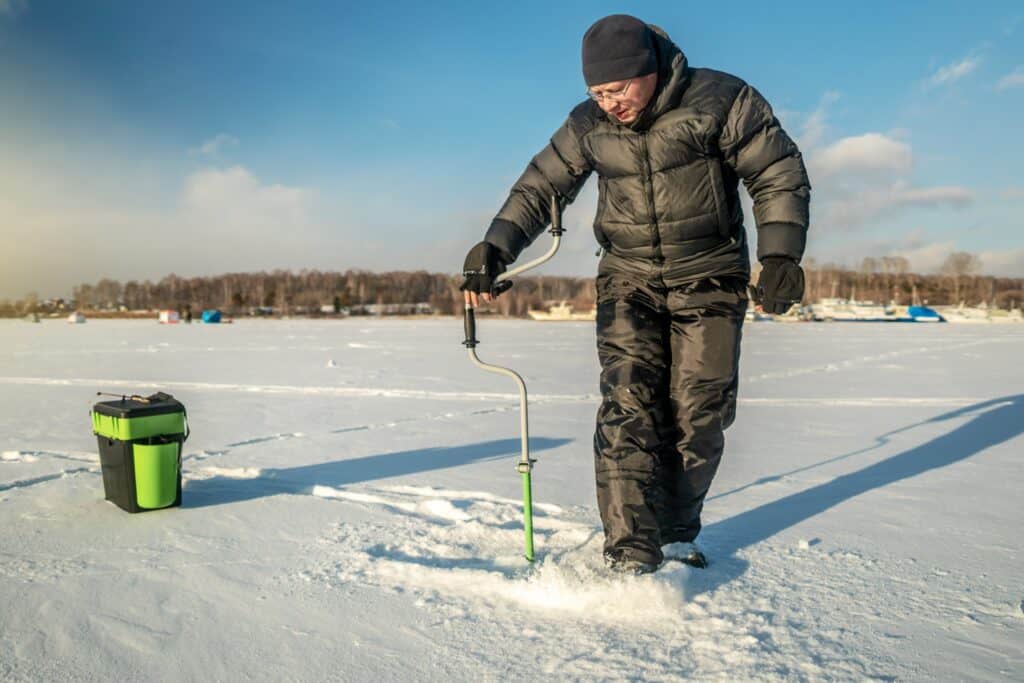
4. Selecting an Ice Auger
Choosing the right ice auger is crucial for a successful and enjoyable ice fishing experience. An ice auger is used to drill holes in the frozen surface of lakes or rivers, allowing you to access the water below and fish through the hole. When selecting an ice auger, various components should be taken into account, including the type, size, power source and blade material.
Type of Ice Augers
There are three main types of ice augers: hand-powered (manual), gas-powered, and electric. Each has its own advantages and disadvantages:
- Hand-Powered: These manual augers require physical effort to drill holes but are lightweight and budget-friendly. They’re best suited for occasional use or shallow waters with thinner ice layers (source).
- Gas-Powered: Gasoline-fueled engines provide more power than manual options, making them suitable for drilling multiple holes quickly on thick ice surfaces. However, they can be noisy and emit fumes (source).
- Electric: Battery-operated electric augers offer a quiet operation without emissions while still providing ample power for most situations (source). They may not last as long between charges compared to gas models, but advancements in battery technology have improved their performance and longevity.
Size of Ice Auger
The diameter of the auger’s blade determines the size of the hole you’ll drill. Common sizes range from 4 to 10 inches. Consider your target fish species when selecting a size:
- Smaller Fish: A smaller hole (4-6 inches) is suitable for panfish or trout.
- Larger Fish: For targeting larger species like walleye, pike, or lake trout, opt for an auger with a larger diameter (8-10 inches).
Power Source and Blade Material
Your choice between gas-powered or electric ice augers will depend on personal preference and intended use. Gas models are ideal if you need more power and longer run times without recharging batteries (source). Electric options are eco-friendly alternatives that provide sufficient power for most anglers while being quieter during operation.
The material used in constructing the blades also plays a role in overall performance. Stainless steel blades offer durability and resistance to rusting, while carbon steel provides sharpness but may require more frequent sharpening due to wear.
Key Points To Remember:
Choosing the right ice auger is crucial for a successful and enjoyable ice fishing experience. There are three main types of ice augers: hand-powered, gas-powered, and electric; each has its own advantages and disadvantages. The diameter of the auger’s blade determines the size of the hole you’ll drill, so consider your target fish species when selecting a size.
5. Best Ice Fishing Line
The right line can make all the difference in catching fish and having an enjoyable experience. In this section, we will guide you through choosing the perfect line for your ice fishing adventure.
A. Types of Ice Fishing Lines
There are three main types of lines used for ice fishing: monofilament, fluorocarbon, and braided lines. Each has its advantages and disadvantages depending on your needs:
- Monofilament: This type of line is affordable, easy to handle, and offers good knot strength. It’s also less visible underwater than other options making it great for clear water conditions or when targeting skittish fish species like trout or walleye (source). However, it tends to retain memory which can cause coils or tangles in cold temperatures.
- Fluorocarbon: Fluorocarbon lines have low visibility underwater due to their refractive index being similar to that of water (source). Braided lines offer better sensitivity and hook-setting power, due to their minimal stretch, while also providing higher strength-to-diameter ratios for thinner diameter lines.
- Braided: Braided lines offer high strength-to-diameter ratios allowing you to use thinner diameter lines without sacrificing strength (source). They also have minimal stretch, providing better sensitivity and hook-setting power. However, they are more visible underwater than monofilament or fluorocarbon lines.
B. Line Weight and Diameter
When selecting the ideal ice fishing line for your requirements, ponder over both the size of the fish you plan to catch and also the diameter of your line. Lighter lines with smaller diameters will be less visible to fish but may not hold up against larger species. Heavier lines offer greater strength but can be more easily detected by wary fish.
- Panfish: For targeting panfish like crappie or bluegill, a lighter line in the 2-6 lb test range is recommended (source).
- Walleye and Trout: A medium-weight line in the 6-10 lb test range works well for walleye and trout fishing on ice (source).
- Northern Pike and Lake Trout: When targeting larger species like northern pike or lake trout, opt for a heavier line in the 10-20 lb test range (source).
C. Color Considerations
The color of your ice fishing line can also play a role in its effectiveness. Some anglers prefer clear or low-visibility colors like green, while others opt for high-visibility options such as neon yellow or orange to help them detect subtle bites and monitor line movement. Ultimately, the choice comes down to personal preference and fishing conditions.
D. Line Maintenance
To ensure your ice fishing line performs at its best, it’s important to properly maintain it by keeping it clean and free of debris. Additionally, be sure to store your line in a cool, dry place away from direct sunlight when not in use (source). This will help prevent degradation over time, ensuring you get the most out of your investment.
Having the correct ice fishing line can make or break your outing, so ensure you select one that meets your requirements. Preparing for an ice fishing outing requires having the required equipment organized and in place.
Key Points to Remember:
Choosing the right ice fishing line is crucial for a successful day on the ice. There are three main types of lines to consider: monofilament, fluorocarbon, and braided lines. Factors such as weight, diameter, color considerations and proper maintenance should also be taken into account when selecting your line.
Also check out our guide to the best tools for trout fishing.
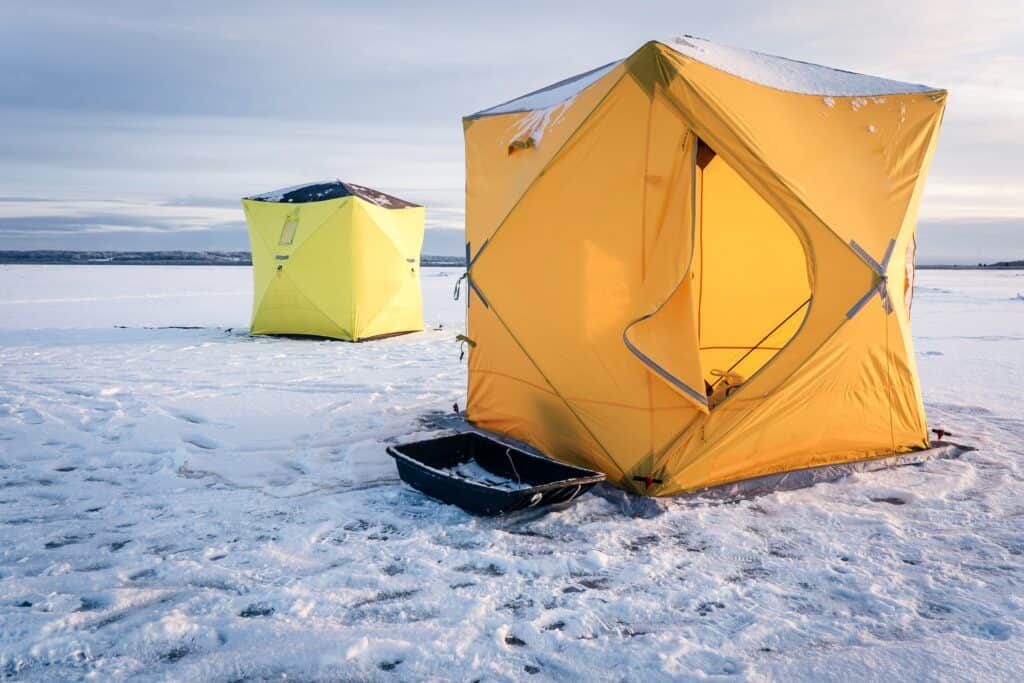
6. Tips for Setting Up Your Ice Fishing Gear
To ensure you have the best experience possible, here are some helpful tips for setting up your ice fishing gear.
A. Organize Your Tackle Box
Before heading out onto the ice, make sure your tackle box is organized and stocked with all the necessary equipment. This includes various sizes of hooks, sinkers, swivels, lures, jigs, bobbers, and more. Having everything neatly arranged will save you time when setting up your gear on the ice.
B. Choose The Right Rod And Reel Combo
Selecting an appropriate rod and reel combo for ice fishing can greatly impact your success rate during outings. Consider factors such as rod length (shorter rods are better suited for tight spaces), power rating (light or medium-light action works best), sensitivity (for detecting subtle bites), and reel type (inline reels are popular among avid anglers).
C. Spool Your Line Correctly
To avoid line twists or tangles while reeling in fish from beneath the icy surface, it’s important to spool your fishing line correctly onto the reel before hitting the frozen waterways:
- Select a high-quality, low-memory line designed specifically for ice fishing.
- Fill the spool of the reel almost to its brim, making sure that it is neither too full nor too empty.
- Apply a light coating of line conditioner to reduce friction and improve casting performance.
D. Rig Your Rod With The Right Terminal Tackle
Rigging your rod with appropriate terminal tackle is essential for attracting fish beneath the ice. Popular options include:
- Jigs: These versatile lures can be tipped with live bait or soft plastics and are effective at targeting various species through the ice.
- Tip-ups: A classic setup that allows anglers to cover multiple holes simultaneously while waiting for bites on their main rod-and-reel combo.
- Bait rigs: Combining live bait (such as minnows) with small hooks and sinkers creates an enticing presentation for hungry fish lurking below the surface.
E. Stay Safe And Warm On The Ice
Last but certainly not least, remember to prioritize safety when setting up your gear on frozen waterways. Wear proper clothing layers, use caution when drilling holes, and always have a buddy system in place during outings. For more detailed information on staying safe while ice fishing, check out our section on Safety Tips When Ice Fishing.
Properly setting up your ice fishing gear is essential for a successful and safe outing. Essential safety measures to bear in mind when venturing onto the ice should not be overlooked.
Key Points To Remember:
To have a successful and enjoyable ice fishing experience, it’s important to organize your tackle box, choose the right rod and reel combo, spool your line correctly, rig your rod with appropriate terminal tackle, and prioritize safety on the ice. Popular options for terminal tackle include jigs, tip-ups, and bait rigs. Remember to dress warmly in layers and use caution when drilling holes.
7. Safety Tips When Ice Fishing
Ice fishing can be an exciting and rewarding outdoor activity, but it’s essential to prioritize safety while out on the ice. By following these important tips, you’ll ensure a fun and safe experience for everyone involved.
A. Check Ice Thickness
Before venturing onto the ice, always check its thickness. A minimum of 4 inches is recommended for walking or fishing, while 5-7 inches are needed if using a snowmobile or ATV. Remember that ice thickness can vary across different areas of the lake or pond, so make sure to check multiple spots before setting up your gear.
B. Dress Appropriately
Dressing in layers is key when spending time outdoors during winter months – especially when sitting still for long periods while ice fishing. Start with moisture-wicking base layers followed by insulating mid-layers like fleece or down jackets and finish off with waterproof outerwear to protect against wind and wet conditions. Don’t forget warm gloves, hats, and insulated boots.
Cold Weather Clothing Checklist:
- Moisture-wicking base layer (tops & bottoms)
- Fleece jacket/pants (mid-layer)
- Waterproof/breathable outer shell (jacket & pants)
- Gloves/mittens
- Hat/beanie/headband
- Socks made from wool or synthetic materials
C. Bring Essential Safety Gear
In addition to your fishing tools, it’s crucial to pack some essential safety gear. Items like ice picks, a whistle, and a throwable flotation device can be lifesavers in an emergency situation.
Essential Safety Gear:
- Ice picks (to help pull yourself out of the water)
- Whistle (for signaling for help)
- Throwable flotation device (in case someone falls through the ice)
D. Fish with Friends
Fishing with friends or family members not only makes for a more enjoyable experience but also adds an extra layer of safety should any issues arise while on the ice. Plus, you’ll have someone to share your catch with at the end of the day.
E. Be Aware of Changing Conditions
Ice conditions can change rapidly due to factors such as temperature fluctuations and snowfall. Keep an eye on the weather and be prepared to adjust your plans if needed, being sure to prioritize safety.
Key Points to Remember:
When ice fishing, it’s important to prioritize safety by checking the thickness of the ice, dressing appropriately in layers, bringing essential safety gear such as ice picks and a throwable flotation device, fishing with friends or family members for added safety and being aware of changing conditions. By following these tips and staying vigilant about potential hazards, you’ll ensure that your next ice fishing adventure is both fun-filled and safe.
FAQs in Relation to Best Ice Fishing Tools
What is the Best Equipment for Ice Fishing?
The best equipment for ice fishing includes a high-quality ice fishing rod, appropriate tackle such as jigs and lures, a reliable reel, an efficient ice auger, strong line designed specifically for cold temperatures, and essential safety gear. It’s also beneficial to have electronics like fish finders or flashers to locate fish beneath the ice.
What Tools are Used in Ice Fishing?
Tools commonly used in ice fishing include an ice auger for drilling holes through the frozen surface; a skimmer to remove slush from the hole; specialized rods, reels and lines designed for cold weather conditions; various types of tackle including jigs, spoons and live bait; tip-ups that signal when there’s activity on your line; portable shelters called shanties or huts; heaters to keep warm while waiting patiently.
Who Makes the Best Ice Fishing Jigs?
Some of the top manufacturers known for producing high-quality and effective ice-fishing jigs include Rapala (known especially for their Jigging Rap series), Clam Outdoors (makers of the Drop Series jig), Northland Fishing Tackle (with their Buck-Shot Rattle Spoon), and VMC (popularly known for their Tingler Spoon). These companies offer innovative designs with proven success rates among anglers.
Is a Fish Finder Better than a Flasher for Ice Fishing?
Both fish finders and flashers serve similar purposes but cater to different preferences. Flashers provide real-time information about water depth, temperature, and location of fish below you. Fish finders typically offer more detailed images using sonar technology but may not be as instantaneous as flashers. Ultimately, it depends on the angler’s preference and budget when choosing between the two.
Conclusion
From choosing the right ice fishing rod to selecting an ice auger, having the best equipment is crucial for success. Essential tackle like reels and lines are also important considerations when preparing for your next trip.
It’s important to prioritize safety when ice fishing by following tips such as checking ice thickness and wearing appropriate clothing. With these Best Ice Fishing Tools in hand, you’ll be ready to hit the frozen waters with confidence.


